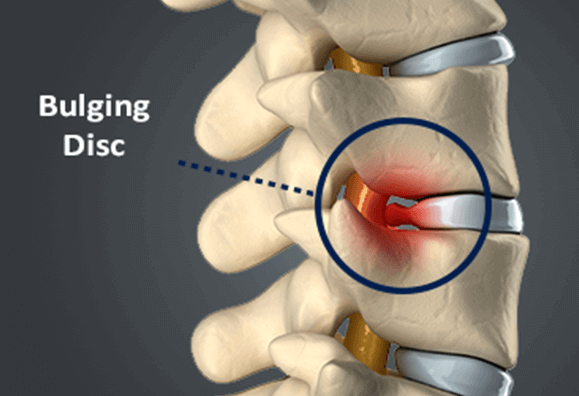Bulging Disc in Lower Back
A bulging disc in the lower back can occur at any of the vertebrae that compose the lumbar spine, described as L1 to L5, which span from the waist to the top of the hips. A bulging disc occurs when pressure located in the central portion of the disc stretches out the outer layer of the spinal disc causing it to bulge.
Overview
Almost 90 percent of bulging disc occurs in the lumbar area of the spine, followed by cervical bulging disc. Lumbar bulging discs are very common – however, in most cases, they appear asymptomatic.
What is a Bulging Disc in the Lower Back
A bulging disc is also known as a disc protrusion, which occurs when pressure from the core of the disc stretches out the outer rim, causing a bulge or protrusion on the disc. When left unattended, the protrusion may continue until the disc tears, leading to a herniated disc.
Causes of a Bulging Disc in the Lower Back
The primary cause of bulging disc in the lower back is age. With time, the spinal discs begin to lose water content, making them less efficient at absorbing shock. This causes a lumbar disc to lose its natural elasticity, making them flatter, stiffer, and more susceptible to any trauma that can increase pressure, leading to bulging discs.
Bulging disc can occur as early as in the 20s, but it most often affects people between 35 to 50. A bulging disc in the lower back is also associated with:
- Repetitive driving, standing, bending for prolonged periods
- Improper lifting
- Excessive alcohol consumption
- Smoking
- Unexpected trauma
- Family history of disc disease
Symptoms of a Bulging Disc in Lower Back
Symptoms of a lumbar bulge disc often originate at the location of the damaged disc and affect adjacent nerves. Discomfort in the lower back that develops into shooting pain down the buttocks is a common symptom. However, symptoms vary per location and severity of the bulge. The most common symptoms people experience include:
- Leg pain that radiates to the feet
- Numbness, tingling, or weakness in legs, feet, or toes
- Acute lower back pain
- Pain that worsens with movement or while sitting
Key symptoms may change according to the location of the bulged disc and the adjacent nerves being impinged. The most common located symptoms of a bulging lumbar disc can be:
- S1: May cause pain that radiates to the outside of the calf, loss of ankle reflex, and weakness while standing.
- L3 or L4: Pain is radiating to the quadriceps at the front of the thigh, accompanied by abnormal reflexes.
- L5: Difficulty with heel-to-toe coordination in walking, numbness, and pain that radiates into the buttocks, and weakness into the toe and ankle.
Diagnosis
The diagnosis of a bulging disc in the lower back begins with a complete family medical history assessment in conjunction with physical examinations. During diagnosis for a bulging lumbar disc, the physician may inquire about:
- Type and severity of pain experienced
- Related medical conditions
- Lifestyle habits
- Work history
- Family and medical history
- Rundown of symptoms
Exams & Tests
Once the initial medical examination is completed, a physician may continue to check symptoms and look for activities that trigger the symptoms experienced. After the initial consultation, the doctor may perform several exams, including:
- A neurological check
- Range of motion test
- Leg raise exam
- Vital signs monitoring
- Gait monitoring
- A lumbar spine area examination
Also, imaging tests for lumbar bulging discs may be requested to locate the actual spinal disc causing the problem. These imaging tests are commonly prescribed for finding bulging discs:
- Magnetic Resonance Imaging (MRI): Provides full visualization of the lumbar spine area
- Computed Tomography (CT Scan): Helps detect subtle cases of nerve pressing
- X-Rays: Gives a clear view of abnormal intervertebral discs
- CT Myelogram: Outlines the spinal cord and nerves, revealing any abnormality
- Electromyography (EMG): Test for nerve damage in the area
Treatment for a Bulging Lumbar Disc
In most cases, treatment begins with conservative treatment, which includes over-the-counter medication, hot and cold compression, or physical therapy. In cases where conservative treatment fails to provide relief, surgery may be required to provide lasting relief.
Non-Surgical Treatment
If the symptoms associated with a lumbar bulged disc don’t interfere with daily activities or don’t pose any risk of evolving to other spinal conditions, non-surgical treatment can provide pain relief. In most cases, non-surgical treatment will involve:
- NSAIDs
- Steroidal injections
- Physical therapy
- Exercise
- Rest
- Acupuncture
- Chiropractic Care
- Hot and Cold Therapy
- Prescribed medication
Surgical Treatment
When the non-surgical treatment proves ineffective at providing comfort from the symptoms associated with a bulging lumbar disc, surgery may be needed. Spine surgery can help treat the symptoms linked to the condition, as well as address the underlying cause of a bulging lumbar disc. The Bonati Spine Institute offers an array of procedures to treat bulging discs. These procedures may include:
- Lumbar Foraminectomy/Foraminotomy
- Lumbar Discectomy
- Lumbar Laminectomy/Laminotomy
Prevention & Self-Care
A bulging disc in the lower back can be caused by the natural degeneration of the spine. However, there are certain prevention tactics patients can do to reduce the stress placed on the lumbar spine and avoid chances of developing a bulging lumbar disc. For example:
- Keeping a good posture
- Avoiding standing or sitting for prolonged periods
- Stretching
- Stop smoking
- Reducing alcohol consumption
- Exercising
- Maintaining a healthy diet
- Avoiding improper lifting or pushing movements
Check out one of our patient’s stories of recovery from a bulging disc by clicking here.

